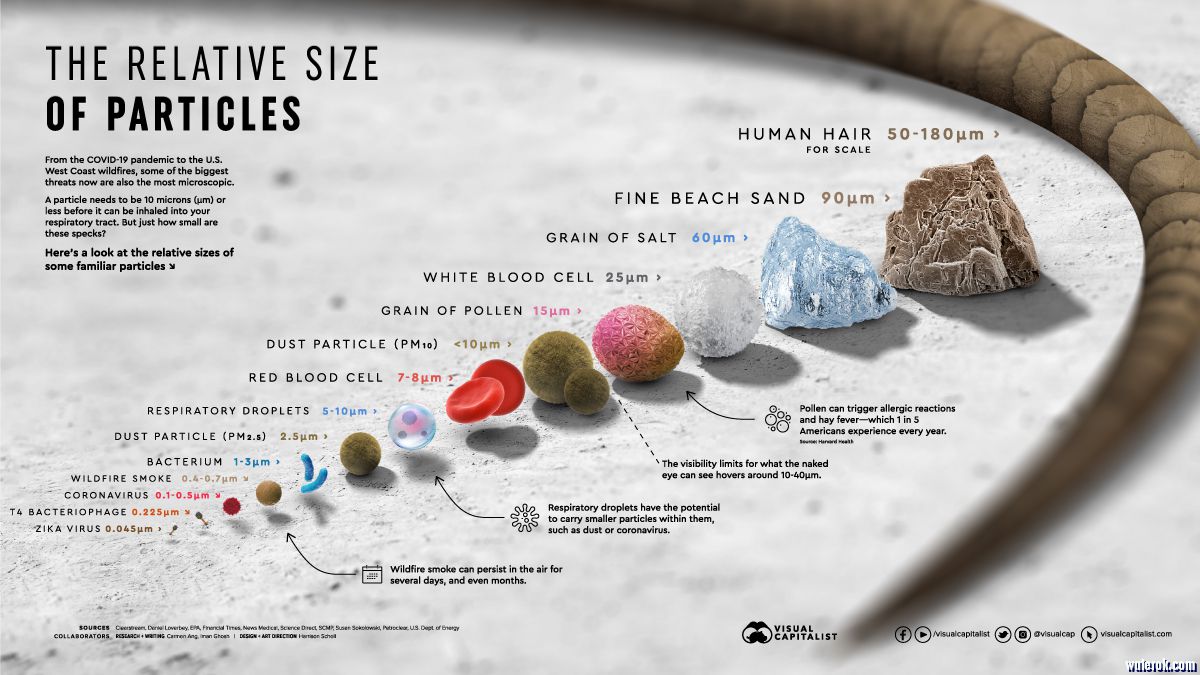https://www.visualcapitalist.com/visualizing-relative-size-of-particles/
0 o6 z5 d5 m$ c, P9 [0 r
$ o. Y' H3 g- _+ d- @% w: m* M8 ^1 q. W, p% x f& |
 ' R/ N7 W" r; x& ^" Z! S ' R/ N7 W" r; x& ^" Z! S
Published 3 weeks ago on October 10, 2020
: O; b' p. T$ F7 s, X: ]By Carmen Ang/ o) _8 Y- o" M' ?
, B1 t2 o# m- ]3 C
i" Z% Z& ~0 _( Q" Y( N9 ]7 N5 Z% w% L
6 ^ {7 }) r2 V. r; k, k
: h* |# P" B7 Q) {" d* ?0 `& s$ X
; y# k% b7 @% `) _3 }0 S; |' g, d; j+ z0 N* [+ X
Zooming In: Visualizing the Relative Size of Particles[size=1.1]View the high resolution of this infographic by [url=https://www.visualcapitalist.com/wp-content/uploads/2020/10/RelativeSizeofParticles-Infographic-1920px_v8.jpg]clicking here. [size=1.1]

[size=1.1]Lately, the world’s biggest threats have been microscopic in size. [size=1.1]From the global COVID-19 pandemic to wildfires ripping through the U.S. West Coast, it seems as though our lungs can’t catch a break, or more aptly, a breath. [size=1.1]But just how small are the particles we’re currently battling? And how does their size compare to other tiny molecules? Specks Too Small to See[size=1.1]While the coronavirus that causes COVID-19 is relatively small in size, it isn’t the smallest virus particle out there. [size=1.1]Both the Zika virus and the T4 Bacteriophage—responsible for E. coli—are just a fraction of the size, although they have not nearly claimed as many lives as COVID-19 to date. [size=1.1]Coronavirus particles are smaller than both red or white blood cells, however, a single blood cell is still virtually invisible to the naked eye. For scale, we’ve also added in a single human hair as a benchmark on the upper end of the size range. Particles Average Size (microns, μm)
- V! x( N; W5 p5 f+ z6 EZika virus 45nm ' p0 B1 t/ V" y( K5 D. _& M2 u
T4 Bacteriophage 225nm
' G' p( `& R. Y8 `4 m; b( SCoronavirus
& h( i9 F3 }! t# o5 H3 {COVID-19 (SARS-CoV-2) 0.1-0.5μm / `+ J9 c2 ?, b: z; r0 l; I
Bacterium 1-3μm
2 l' ]7 Z5 b7 h$ K* vLight dust particle 1μm , V1 ?* S% X( n$ Q q# K4 Z9 t
Dust particle: PM2.5 ≤2.5μm / k4 c0 Y0 a9 D# I; v8 C* b: f
Respiratory droplets containing COVID-19 5-10μm 8 P% Z7 w6 ]9 J% e4 K, { o6 U0 t
Red blood cell 7-8μm
8 z* H# J' u) b9 g0 ODust particle: PM10 ≤10μm
+ g9 X b2 ?9 ~. l/ n, ^Pollen grain 15μm 1 B' D! a9 P6 E% i# u
White blood cell 25μm ; G g! a- _( n+ L
Visibility threshold- ]! w8 i. r- n4 w2 q
(Limit of what the naked eye can see) 10-40μm , d8 M& x4 I2 Q6 P$ r1 O+ L
Grain of salt 60μm
9 ?. F Y6 l8 S/ t( g5 [Fine beach sand 90μm 4 c5 U0 l0 D1 S" C7 g, m4 d% M: f
Human hair 50-180μm [size=1.1]On the other end of the spectrum, pollen, salt, and sand are significantly larger than viruses or bacteria. Because of their higher relative sizes, our body is usually able to block them out—a particle needs to be smaller than 10 microns before it can be inhaled into your respiratory tract. [size=1.1]Because of this, pollen or sand typically get trapped in the nose and throat before they enter our lungs. The smaller particles particles, however, are able to slip through more easily. Smoky Skies: Air Pollution and Wildfires[size=1.1]While the virus causing COVID-19 is certainly the most topical particle right now, it’s not the only speck that poses a health risk. Air pollution is one of the leading causes of death worldwide—it’s actually deadlier than smoking, malaria, or AIDS. [size=1.1]One major source of air pollution is particulate matter, which can contain dust, dirt, soot, and smoke particles. Averaging around 2.5 microns, these particles can often enter human lungs. [size=1.1]At just a fraction of the size between 0.4-0.7 microns, wildfire smoke poses even more of a health hazard. Research has also linked wildfire exposures to not just respiratory issues, but also cardiovascular and neurological issues. [size=1.1]Here’s an animated map by Flowing Data, showing how things heated up in peak wildfire season between August-September 2020:
3 A8 J$ f* q! |/ S2 ^# g[size=1.1]What’s the main takeaway from all this? [size=1.1]There are many different kinds of specks that are smaller than the eye can see, and it’s worth knowing how they can impact human health.
/ w. x; j# ?& A, A- C9 X$ Q* d |  |Archiver|手机版|小黑屋|水易网[水处理技术论坛]
( 京ICP备05078561号 )
|Archiver|手机版|小黑屋|水易网[水处理技术论坛]
( 京ICP备05078561号 )